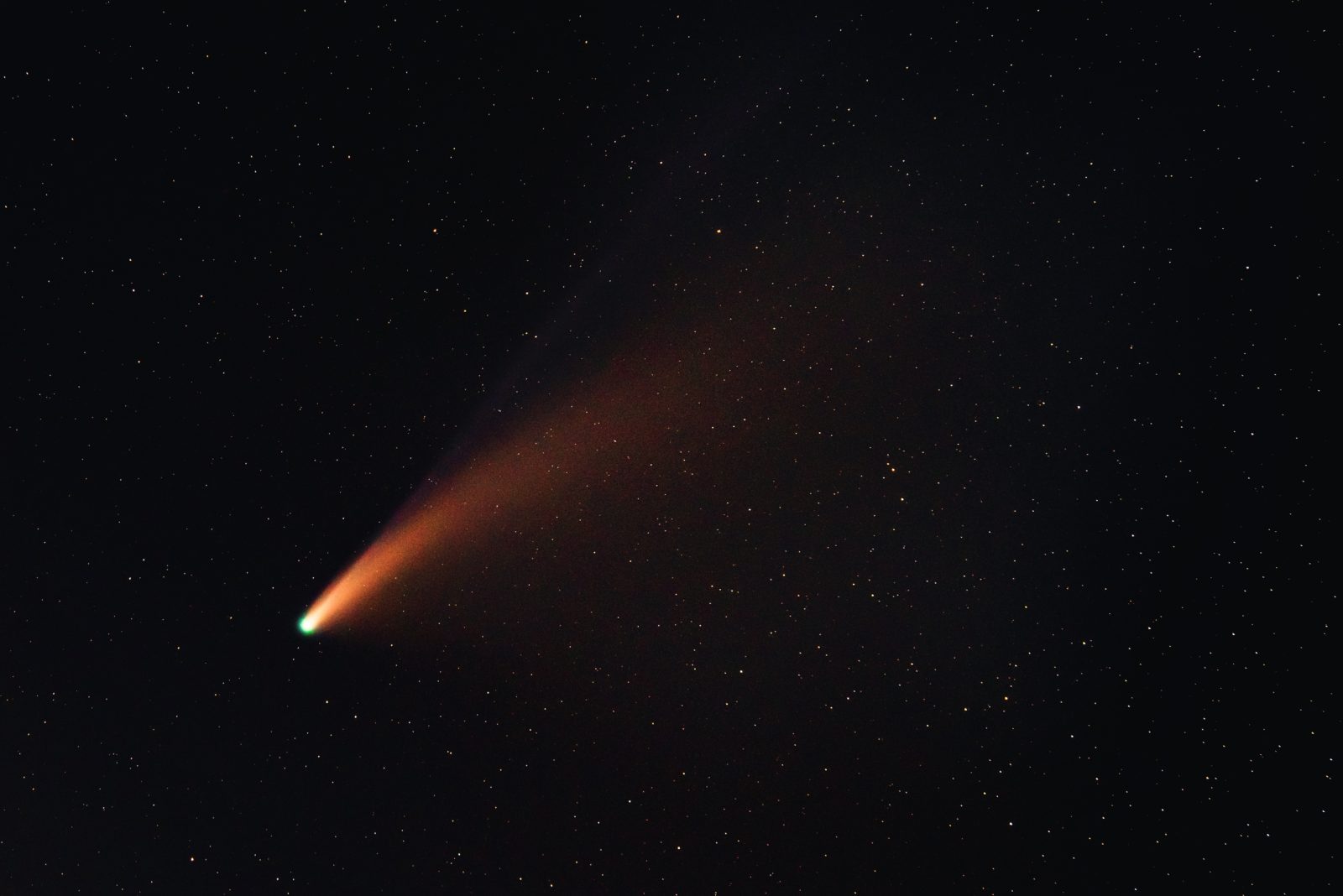Comet C/2022 E3 (ZTF) is approaching Earth and has already passed the limit of naked-eye visibility. It can now be seen well with small telescopes and conventional triaxes, and early observers report visibility without instruments. The comet has been visible all night since mid-January and should reach its peak brightness in late January and early February. However, when it comes to naked-eye viewing, astronomers are tempering their hopes.
Comet C/2022 E3 (ZTF), nicknamed the “Neanderthal Comet” by the media because its last return to the Sun and Earth was about 47,500 years ago, is approaching Earth and continuing to brighten.
“The period of best visibility is therefore still ahead of us,” Martin Mašek of the Czech Astronomical Society pointed out, adding that astronomers are nonetheless dampening their enthusiasm for the “bright comet flying through the sky.”
“It won’t be a very bright comet, like comet C/2020 F3 (NEOWISE) was in 2020, but already several experienced observers are reporting the visibility of the comet with the naked eye under dark skies far from cities, on the night of Tuesday, January 24, for example, from Kozákov,” he added.
Some observers were also supposed to have seen it with the naked eye last week. However, according to astronomers’ statements to the News, the sighting was made under the most ideal conditions and suitable weather. They were also said to be “sharp-eyed individuals.”
The comet’s two tails are depicted in the first image: a long, ionized tail and a bright, dusty tail. The dusty tail of comet ZTF is curving away from us due to its position relative to the Earth and the Sun. This gives us an increasingly unusual view of the comet. Also striking is the green color of the comet’s head, caused by sublimating cyanide in the comet’s head (coma).
Its closest approach to us will be on February 1. This is not the first time this comet has passed the sun. Before its current entry into the inner parts of the Solar System, it was on a strongly elongated elliptical orbit for about 47 500 years. It had at least one consecutive orbit around the Sun.
C/2022 E3 will pass through occultation (the closest point in its orbit to the Sun) on January 12, 2023, at a distance of 166.3 million kilometers from the Sun. It will be closest to Earth on February 1, 2023, coming within 42.5 million km of our planet). “Thus, its highest brightness is expected in late January and early February,” Mašek said.
At the same time, it should reach its maximum brightness, around 5 mags. In the sky outside the city, experienced observers could easily see it with the naked eye as a tiny, hazy star.
The comet is now visible with conventional triaxes and small telescopes. At the same time, in perfect viewing conditions – outside cities and under very dark skies – the first people are reporting its visibility with their eyes. Its motion across the sky slowly accelerates as it gets closer to Earth. The comet has already entered the so-called circumpolar region of the sky, i.e., it does not fall below the horizon and can be seen all night.
On January 21, it passed into the constellation of the Dragon; on Wednesday, January 25, it will enter the Little Bear; on January 30, it will pass just 10 degrees from Polaris. According to astronomer Pavel Suchan, we will see it in the region between the Big Dipper and the Little Dipper.
The first day of February will be the closest, but from February 2 onwards, the moon will start to interfere strongly, as the full moon will have already set in on February 5. Moonless skies await the comet again on February 8, when it will move through the constellation of the Wagon. On February 9, it will enter the constellation Taurus. In Taurus, high in the winter sky, we will see the comet near the bright planet Mars on February 11 and 12.
By then, its brightness will have dropped below naked-eye visibility, but it will be readily observable in trituration until the end of February. It will be visible in small telescopes (with a diameter of 7 cm) until the end of March when it will be very low on the horizon in the constellation Eridanus.
It will not return
After passing through the inner parts of the Solar System, the gravitational pull of the giant planets will turn the comet’s orbit into a hyperbola, leaving the Solar System forever.
“Yes, it won’t come back,” Suchan confirmed despite earlier reports. “This is the last chance to see it.”









%%
Feel free to visit my web site; Link building agency uk
%%
Feel free to surf to my web page: shop bunk Beds
%%
My blog Electrician Uk
%%
Stop by my homepage; top
%%
Look into my page buy cbd e-Liquids, daeok.247realmedia.kr,
%%
Stop by my web blog: Media Asbestos
%%
My web blog – Delta 8 nearme (test.dragonstar.ru)
%%
Feel free to surf to my web page; Most Famous pornstars
%%
my webpage :: togel hongkong (Mary)
%%
Here is my site: vegan cbd Gummies uk; http://vvboard.net.cn,
%%
My website; Stores That Sell Delta 8 Near Me
%%
Review my site – delta 9 thc gummies near me
%%
Here is my webpage :: pragmatic Play – http://www.Rybalka44.Ru –
%%
Feel free to surf to my webpage – Togel Online – http://Www.Turlt.Com,
%%
Have a look at my web-site; Double glazing
%%
Here is my page: togel online (http://outdoorunderwriters.net/__media__/js/netsoltrademark.php?d=www.zaharina.co.uk)
%%
my homepage; togel online (Mariano)
%%
Feel free to visit my web blog – Poker Online (rvmontessorischool.com)
%%
Look into my page: Sinton Accident
%%
Also visit my website: cheapest cbd vape cartridge
%%
Also visit my web site … d8
%%
My page … best delta 8 thc edibles [Sherlene]
%%
Feel free to visit my website; Delta 8 Thc Hemp Flowers Online
%%
Here is my blog post – cbd uk full spectrum; Thanh,
%%
my blog post: Benefits Of Full Spectrum Cbd Oil
%%
Here is my blog; Delta 8 Products Near Me
%%
Visit my website – cbd flower For Sale online
%%
my web page :: replacement Double glazing
%%
my web-site … Togel Hongkong – horizonblankets.com –
%%
My web blog … Delta 8 nearby (http://www.fc0377.com)
%%
Here is my web site – full Spectrum cbd oil 1500mg 15%
%%
my site vegan cbd edibles
%%
Check out my web page :: buy cbd hemp Flower Uk
%%
My web blog :: usa Legal Delta 9
%%
My page: delta 10 Thc
%%
Stop by my site :: Delta 8near Me
%%
Feel free to surf to my webpage :: full spectrum vegan cbd gummies – https://batchelor-Albright.mdwrite.net/,
%%
Here is my webpage togel hongkong (ajxmokolxp.cloudimg.io)
%%
Here is my blog :: togel (https://www.forumvancouver.com/proxy.php?link=https://www.rahim.cyou/)
%%
Here is my web blog – buy Thco
%%
my page – mesothelioma law Firm in Macclenny
%%
Feel free to visit my page … Redlands injury
%%
My homepage … Sex doll review
%%
Here is my blog; electrician in hitchin
%%
Look at my web blog Farrell boat accident, vimeo.com,
%%
My web page; Mountain Home Railroad Injuries
%%
my blog post – Internal Injury Compensation Claims
Hi are using WordPress for your blog platform?
I’m new to the blog world but I’m trying to get started and create my own. Do
you need any html coding knowledge to make your own blog?
Any help would be greatly appreciated!
Great blog! Is your theme custom made or did you download it from
somewhere? A design like yours with a few simple tweeks would
really make my blog stand out. Please let me know where you
got your theme. Appreciate it
Right here is the right website for anybody
who hopes to understand this topic. You realize so much its almost tough to argue with you (not that
I actually would want to…HaHa). You definitely put a brand new spin on a subject that’s been discussed for ages.
Excellent stuff, just great!
You made some decent points there. I checked on the net
for more information about the issue and found most
people will go along with your views on this web site.
What’s up, I would like to subscribe for this webpage
to take most up-to-date updates, so where can i do it please assist.
Magnificent goods from you, man. I’ve take into account your stuff prior to and you’re just too wonderful.
I really like what you have got here, certainly like what you are saying and
the way during which you say it. You make it enjoyable and you continue to
take care of to keep it sensible. I can not wait to read far more from you.
This is really a terrific site.
Hi, I check your blogs on a regular basis. Your writing style is witty, keep doing what you’re doing!
Wonderful blog! I found it while surfing
around on Yahoo News. Do you have any suggestions on how
to get listed in Yahoo News? I’ve been trying for a while but I never seem to get there!
Cheers
Genuinely when someone doesn’t know afterward its up to other visitors that they will help,
so here it happens.
I read this post completely about the comparison of latest and earlier technologies, it’s remarkable article.
Hi, the whole thing is going nicely here and ofcourse every one
is sharing data, that’s truly excellent, keep
up writing.
Very rapidly this website will be famous among all blogging visitors, due to
it’s fastidious content
Hi there, for all time i used to check weblog posts here early in the dawn, because i
like to gain knowledge of more and more.